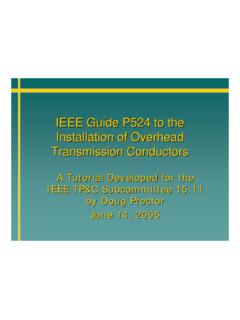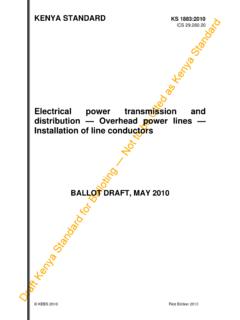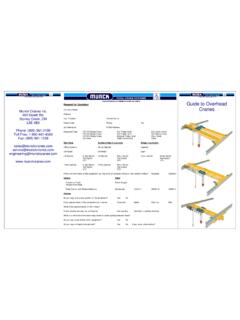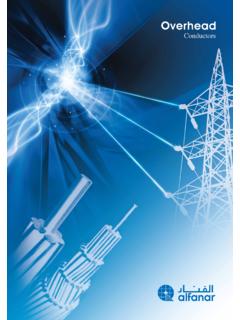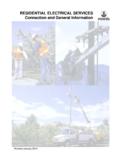Transcription of Guide for Installation of ACSR v1 - Southwire
1 Page 1 of 15 8/10/2017 Version Guide FOR THE Installation OF ACSR & ACSR/TW CONDUCTORS Southwire s Aluminum conductor , Steel Reinforced (ACSR) and Trapezoidal Shaped Wire Aluminum conductor , Steel Reinforced (ACSR/TW) are aluminum conductors with a stranded steel core. ACSR conductors have round wire aluminum strands, while ACSR/TW conductors have trapezoidal shaped aluminum strands for increased ampacity for the same diameter, or reduced diameter for the same conductor size. Figure 1. Comparison of ACSR and ACSR/TW conductors. Southwire recommends that ACSR conductor installations be performed in accordance with IEEE 524 Guide to the Installation of overhead Transmission Line Conductors . This Guide is intended to summarize best practices for installing ACSR and ACSR/TW conductors. Reel Handling and Storage Special care should be taken to ensure that ACSR conductor and reels are not damaged.
2 Unloading equipment must never come in contact with the conductor . Lifting must be performed using a fork lift or crane as described below. When using a fork lift, the forks shall be placed under both flanges, with the flange facing the operator. Page 2 of 15 8/10/2017 Version Figure 2. Forklift handling of reels. When using a crane, a spreader bar must be used in conjunction with either J hooks or an axle to prevent damage to the reel flange and conductor . J hooks should be placed in the arbor holes. Axles should be inserted through the arbor holes and lifted with straps. Figure 3. Crane handling of reels. Reels should be stored away from physical and environmental hazards, such as chemicals. conductor reels must be stored standing on their flanges in a flat, well drained area.
3 The conductor must not be allowed to touch the ground. conductor Oxidation Exposure of conductor to air can cause oxidation to form on the conductor . Oxidation results from a chemical reaction between oxygen and aluminum, yielding an oxide layer on the conductor . While it is normal for oxidation to form, necessary steps should be taken to clean Page 3 of 15 8/10/2017 Version the conductor of oxidation at hardware application areas. The conductor must be brushed in these areas prior to installing hardware to ensure adequate metal to metal contact. Figure 4. Oxidation on a conductor . conductor Staining When conductor reels are stored outdoors, moisture can accumulate on the conductor on the underside of the reel. If the moisture contains chemicals from the surrounding atmosphere, a black stain can appear on the conductor .
4 This has been found to be more prevalent in non specular conductor because the drawing oils have been removed. Figure 5 shows the appearance of a water stain. Figure 5. Water stain on conductor . Water stains are a cosmetic issue; they have no adverse effect on the performance or service life of the conductor . In most environments, the conductor will darken in the first few months after the line is energized, and the stain will no longer be noticeable. Aluminum Association Page 4 of 15 8/10/2017 Version Technical Bulleting TR3, Guidelines for Minimizing Water Staining of Aluminum discusses this issue in detail and contains advice for avoiding water staining. conductor Handling If conductor must contact the ground due to unavoidable circumstances, a smooth, rigid material may be laid in its path to prevent damage.
5 Minor abrasions should not be a cause of concern; most can be sanded or buffed out. In an EHV application, the abrasion should be evaluated for possible corona concerns. Spooling and Training The minimum diameter for spooling of ACSR is 30 times the conductor diameter. The minimum bending radius, or training radius, before permanent deformation occurs is 12 times the conductor diameter. Installation Payoff The conductor reel should be set up on a reel payoff stationed 40 50 feet (12 15 meters) behind and in line with the bullwheel tensioner. This will ensure that the conductor does not scrub the flanges as it is being unwound1. Figure 6. Payoff and bullwheel setup. Proper adjustment of the fairlead roller guides is necessary to prevent scuffing of the conductor as it reeves through the bullwheel. Only enough braking tension should be applied to the reel to 1 IEEE Standard 524 2016 pg.
6 62 Page 5 of 15 8/10/2017 Version prevent the reel from over rotating (free spooling) when the pulling operation stops. A slight droop between the payoff and bullwheel is desirable, as this indicates low tension between the bullwheel and payoff. Back tension should be kept at a minimum. This is especially important for smaller conductor diameters and wooden reels2. If too much back tension is applied, the conductor on the outer layer can pull down into the underlying layers, as in Figure 7. Figure 7. conductor pulldown. Bullwheel Only dual drum multi groove bullwheel tensioners are recommended for multilayered ACSR3. The bullwheel drums may be tilted or offset so that the offset will be approximately one half the groove spacing4. 2 IEEE Standard 524 2016 pg. 69, 3 IEEE Standard 524 2016 pg.
7 52, 4 IEEE Standard 524 2016 pg. 82 Page 6 of 15 8/10/2017 Version Figure 8. Dual drum bullwheel, courtesy of Oncor. Semicircular grooves with depths of or more times the conductor diameter and flare angles of 5 15 from vertical generally are recommended. For multilayer conductors, the number of grooves in the bullwheel must be sufficient to prevent the outer layer of wires from slipping through underlying layers. The minimum bottom groove diameter of the bullwheel should be 39 times the conductor diameter minus 4 inches (10 centimeters). Additional sizing charts and diagrams can be found in IEEE Standard 5245. Bullwheels must be properly sized and lined to prevent scuffing and damaging of the conductor . The conductor should be reeved through the bullwheels such that, when facing in the direction of pull, the conductor will enter the bullwheel on the left side and exit from the right.
8 This orientation is necessary to avoid any tendency to loosen the outer layer of strands5. If lined, durable polymer lined grooves are recommended to avoid permanent scuffing of the surface of the conductor . Semiconducting linings should not be relied on for grounding purposes5. It is important never to break the conductor over a small roller under high tension, as this can permanently damage the conductor . Figure 9 shows an example of the conductor traveling over a small roller (not recommended); Figure 10 shows a suitable roller diversion technique. 5 IEEE Standard 524 2016 pg. 52 53 Page 7 of 15 8/10/2017 Version Figure 9. Adverse interaction of conductor with roller, courtesy of Transpower New Zealand. Figure 10. Suitable technique for roller diversion, courtesy of Transpower New Zealand.
9 The bullwheel should be set up in line with the pull and 3 4 times as far from the base of the structure as the distance from the base of the structure to the height of the entrance block at the first structure6. This is important to ensure the conductor is not pulled over the entrance block at a large angle. 6 IEEE Standard 524 2016 pg. 61 Page 8 of 15 8/10/2017 Version Figure 11. Orientation for bullwheel/payoff setup. Stringing Sheaves7 Sizing recommendations for sheaves should be made by the sheave manufacturer, but typical sizing criteria are discussed below. A minimum bottom groove diameter of 20 times the conductor diameter minus 8 inches (20 centimeters) is generally used for typical pulls [ pulls less than 2 miles (3 kilometers) with level spans and minimal angles]. For pulls over 2 miles (3 kilometers) or with substantially uneven terrain, the bottom groove diameter should be increased by 4 inches (10 centimeters).
10 Entrance sheaves are typically sized at 20 times the conductor diameter. Higher tension pulls or structures with a turning angle greater than 20 may also warrant larger sheaves. For angles between 20 45 , a bottom groove diameter of 25 times the conductor diameter is typically recommended. For angles up to 90 , two sheaves with bottom groove diameters of 25 times the conductor diameter are typically recommended. Sheaves on structures with a turning angle should be supported so that the conductor acts through the center line of the sheave. Measurement A in Figure 12 below shows where to measure the bottom groove diameter. The minimum radius at the base of the groove is recommended to be times the radius of the conductor . The location of this measurement is shown as Measurement B. Sheaves with a groove radius as above may, in general, be used with smaller conductors.

